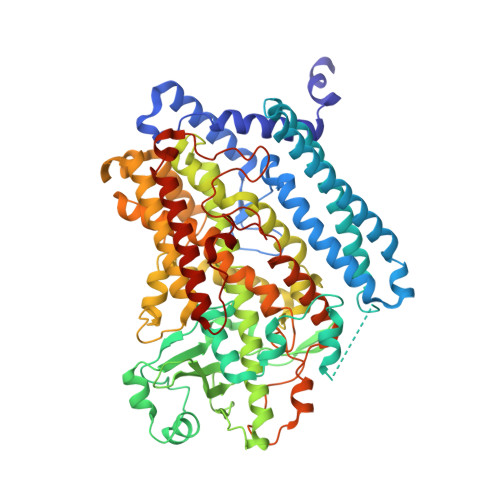The crystal structure of Pseudomonas aeruginosa lipoxygenase Ala420Gly mutant explains the improved oxygen affinity and the altered reaction specificity.
Kalms, J., Banthiya, S., Galemou Yoga, E., Hamberg, M., Holzhutter, H.G., Kuhn, H., Scheerer, P.(2017) Biochim Biophys Acta 1862: 463-473
- PubMed: 28093240
- DOI: https://doi.org/10.1016/j.bbalip.2017.01.003
- Primary Citation of Related Structures:
5LC8 - PubMed Abstract:
Secreted LOX from Pseudomonas aeruginosa (PA-LOX) has previously been identified as arachidonic acid 15S-lipoxygenating enzyme. Here we report that the substitution of Ala420Gly in PA-LOX leads to an enzyme variant with pronounced dual specificity favoring arachidonic acid 11R-oxygenation. When compared with other LOX-isoforms the molecular oxygen affinity of wild-type PA-LOX is 1-2 orders of magnitude lower (Km O 2 of 0.4mM) but Ala420Gly exchange improved the molecular oxygen affinity (Km O 2 of 0.2mM). Experiments with stereo-specifically deuterated linoleic acid indicated that the formation of both 13S- and 9R-HpODE involves abstraction of the proS-hydrogen from C11 of the fatty acid backbone. To explore the structural basis for the observed functional changes (altered specificity, improved molecular oxygen affinity) we solved the crystal structure of the Ala420Gly mutant of PA-LOX at 1.8Å resolution and compared it with the wild-type enzyme. Modeling of fatty acid alignment at the catalytic center suggested that in the wild-type enzyme dioxygen is directed to C15 of arachidonic acid by a protein tunnel, which interconnects the catalytic center with the protein surface. Ala420Gly exchange redirects intra-enzyme O 2 diffusion by bifurcating this tunnel so that C11 of arachidonic acid also becomes accessible for O 2 insertion.
- Institute of Medical Physics and Biophysics (CC2), Group Protein X-ray Crystallography and Signal Transduction, Charité - University Medicine Berlin, Charitéplatz 1, 10117 Berlin, Germany.
Organizational Affiliation:





















